On this page
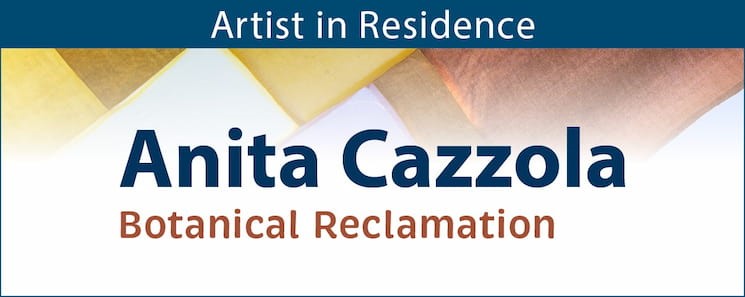
Project overview
In the summer/fall of 2021, Guelph-based artist Anita Cazzola, implemented the Botanical Reclamation project, celebrating the resiliency of wild plants through naturally dyed textiles, and offering the community a chance to learn about local plant life, and the natural dye process through self-guided walks, weekly scavenger hunts, project livestreams, workshops, question and answer sessions, and artist talks with the help of various project partners and collaborators.
Cazzola investigated, ‘Curious Spaces,’ a term she coined referring to natural spaces that have experienced human-inflicted environmental disruption (including the Lafarge Quarry, Eastview Landfill, Eramosa River, and the Ontario Reformatory lands in Guelph), and have begun a return to a natural state through the re-introduction of indigenous and invasive plant species. She gently harvested the plants that had reclaimed these sites to create a body of textile artworks using colours from the plants.
Ultimately, this residency uses the metaphor of plants’ resilience as a means to encourage the community as we overcome a pandemic, reconnect, and re-imagine more harmonious lives together with the natural world. It fosters meaningful interactions with spaces that are less cared for, and expands perspectives of what wild space is and what interacting with nature looks like. Community events and installations provided a space for residents to reflect on their coexistence with natural spaces here in Guelph.
The artist would like to acknowledge that the Botanical Reclamation project is also supported by the Guelph Arts Council through their Jane Graham Memorial award, of which Anita was a recipient for 2020.
Check out Anita’s project website.
Download Anita’s Notes on Natural Dyes.
Concept
Through the process of harnessing colour from plants and applying them to textiles, the community can gain a visual and tactile connection with the power of local plants. Textiles and human bodies are intrinsically connected, and the forms they take in our garments, sheets, furniture, and comfort objects act as a second skin in our daily lives. This tactile and phenomenological relationship makes textiles the perfect medium for a message of resiliency.
Community engagement
The project focussed on process, experimentation, and learning from local plants, and community members’ involvement was essential. By acquiring knowledge about plants and their importance in our ecosystem, participants have become better equipped to advocate for the presence of these species and the preservation of wild spaces. Knowledge about the natural dye process can expand perspectives about the textile industry, creating more awareness of sustainable alternatives to fast fashion & material culture.
Community involvement took many forms and was inclusive to all ages, comfort levels, and physical abilities. Due to COVID-19 many residency offerings were presented virtually.
Dye Plants in Curious Spaces: Weekly Scavenger hunt
Anita shared a weekly ‘dye plant scavenger hunt’ that would focus on a particular dye plant that was in season. The “Dye Plant of the Week” was announced on Sunday mornings (via social media channels), and members of the community were challenged to look for these plants in their local environments throughout the week. Community members were encouraged to send in photographs (and, if possible, coordinates) of the plants they found for inclusion in the “Dye Plants in Curious Spaces” online archive.
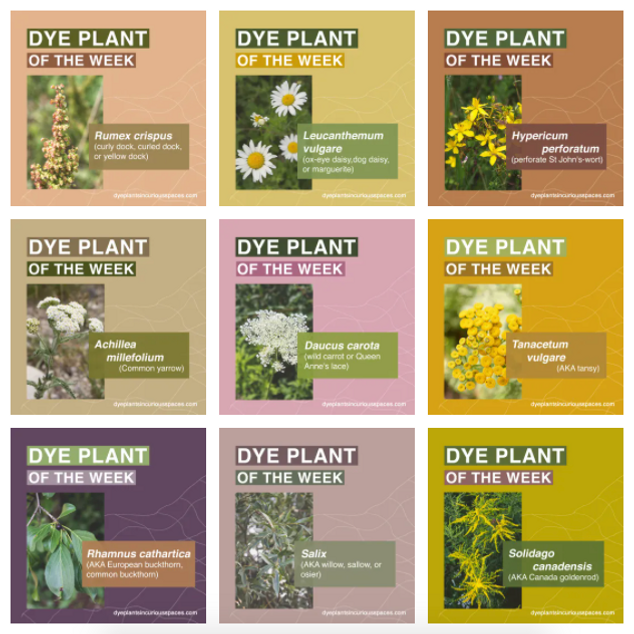
- June 27: Rumex crispus (also known as curly dock, curled dock, or yellow dock)
- July 4: Leucanthemum vulgare (also known as ox-eye daisy, dog daisy, or marguerite)
- July 11: Hypericum perforatum (perforate St John’s-wort)
- July 18: Achillea millefolium (Common yarrow)
- July 25: Daucus carota (also known as wild carrot or Queen Anne’s lace)
- August 1: Tanacetum vulgare (also known as Tansy)
- August 8: Rhamnus cathartica (also known as European buckthorn or common buckthorn)
- August 15: Salix (also known as willow, sallow or osier)
- August 22: Solidago canadensis (also known as Canada goldenrod)
- August 29: Rhus typhina (also known as staghorn sumac)
- September 5: Reynoutria japonica (also known as Japanese knotweed)
- September 12: Juglans nigra (also known as black walnut)
- September 19: Populus tremuloides (also known as trembling aspen or quaking aspen)
Self-guided plant walks
The artist facilitated 3 self-guided plant walks (July 14, August 11, September 29), led virtually by the artist with the help of Zhyfhs Millicent (of Planting Radiance), a certified herbalist, and signage made in collaboration with local illustrator Jenna Kessler.
Anita covered the dye properties of plants, while Zhyfhs shared medicinal properties. Two walks were held at Yorklands Green Hub and one was held along the Eramosa River Trail.
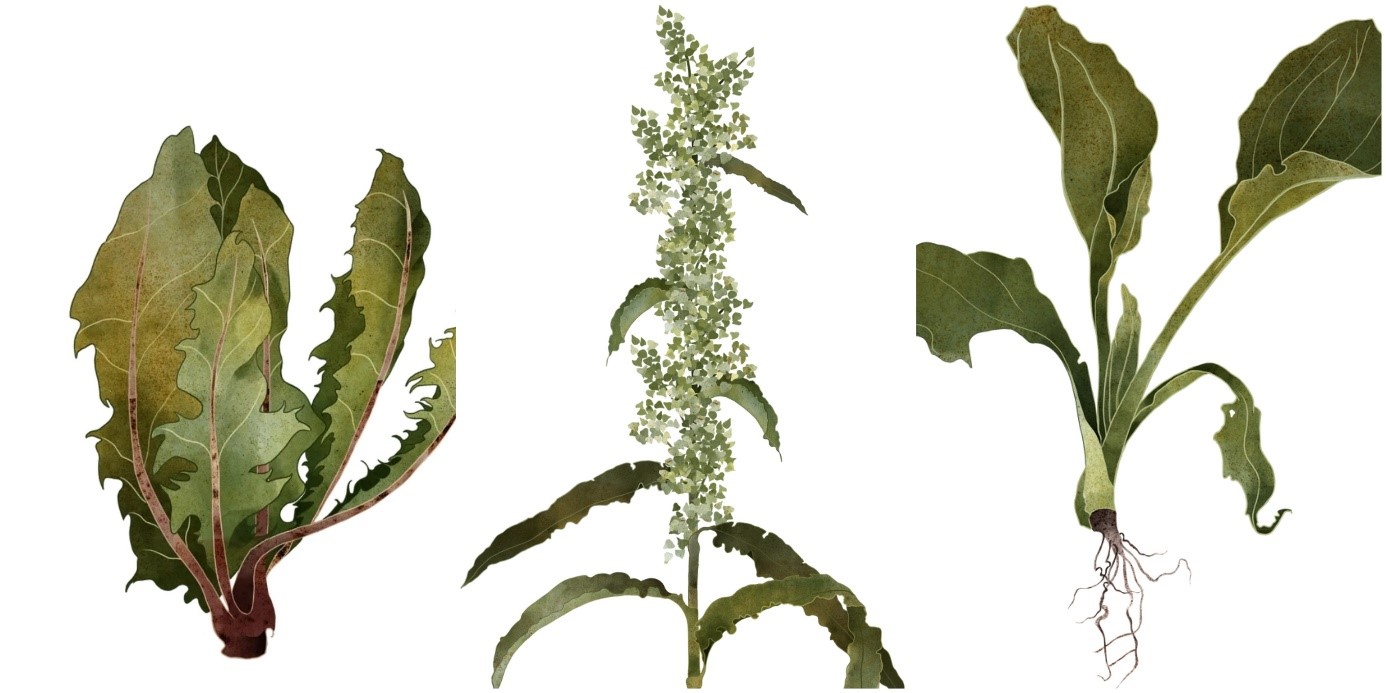
Illustrations by Jenna Kessler
Outdoor Natural Dye workshops
The artist facilitated two Natural Dye Workshops for small groups. Pre-registration was required.
- August 8: Buckthorn workshop at Lyon’s Park
- September 19: Golden Rod, Sumac and Willow at Howitt Park
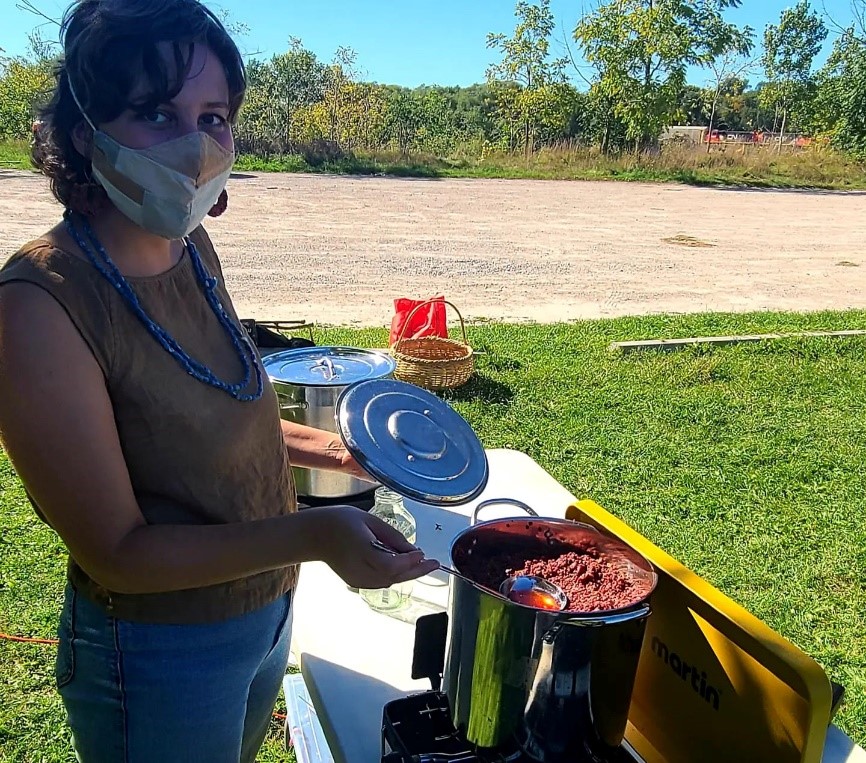
Anita onsite at Howitt Park stirring sumac berries. Photo by Jen Rafter.
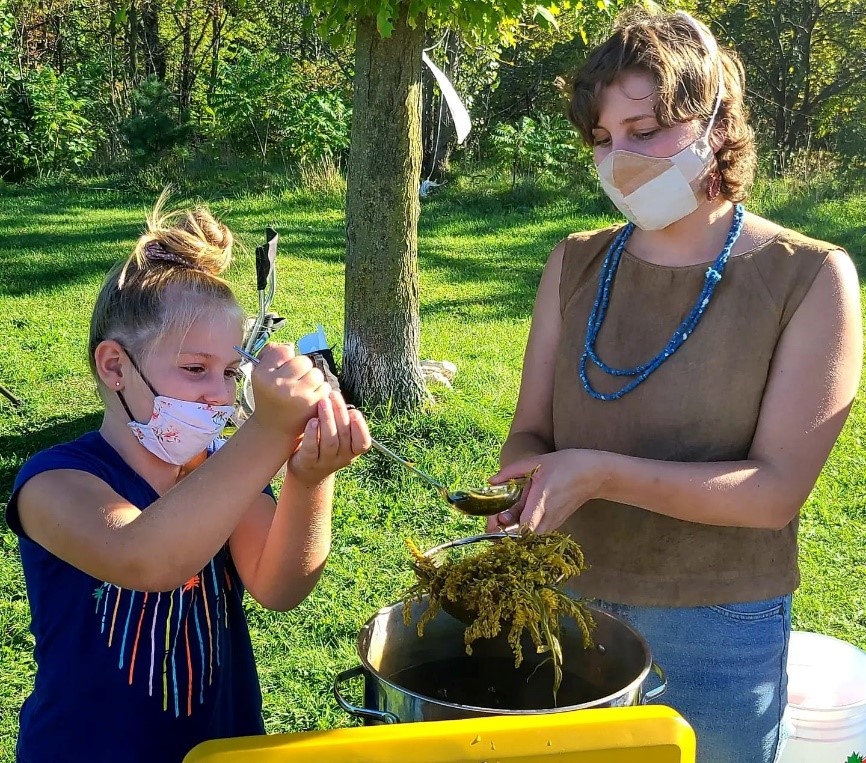
Anita onsite at Howitt Park with young helper straining golden rod. Photo by Jen Rafter.
Artist Talk
The artist presented an artist talk in Market Square, on October 6 at 5:30 p.m., in conjunction with Culture Days, co-presented with 10C. Pre-registration was required.
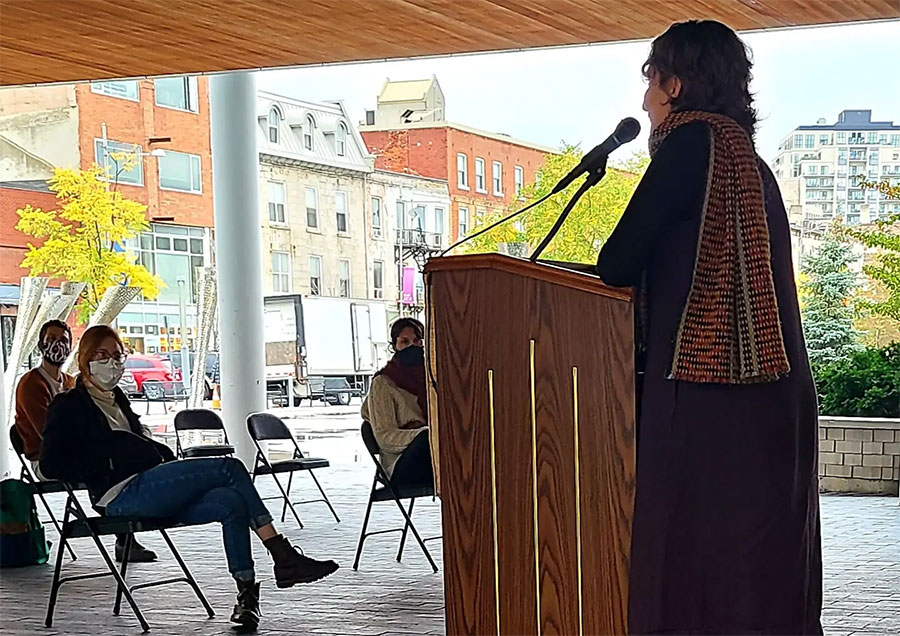
Profile of Anita in Market Square with socially distanced audience at Artist Talk. Photo by Jen Rafter.

Socially distanced audience listening to Anita share under the overhang at City Hall. Photo by Jen Rafter.
Community Conversation, “On Plants, Resilience, and Craft”
In this session, held at the installation site on October 24, at 10 a.m., project themes were discussed with the community, while practical advice regarding environmental stewardship and advocacy was provided. Participants discussed creative ways in which residents can observe and sustainably use plant species in their local neighbourhoods.
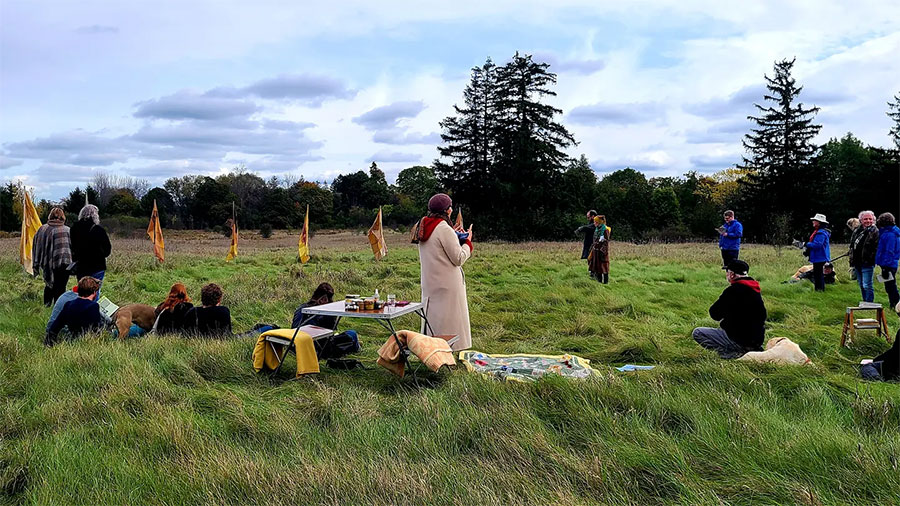
Visitors gathered at Yorklands Green Hub to view artworks and take part in a community conversation about Anita’s project themes. Photo by Jen Rafter.
Artworks
The Botanical Reclamation Installation
The culminating exhibition of work was temporarily installed at Yorklands Green Hub on October 23-24, 2021.
Between the Summer Solstice and the Autumn Equinox, Anita gently harvested 29 varieties of plants to create 45 distinct natural dyes, resulting in hundreds of shades of local colour creating three distinct textile artworks: Infinite Balance, Woven Timeline and Sun Flag.
Each artwork consists of naturally dyed textiles – both fabrics and yarns, and respond to a site that the artist has engaged with. These naturally dyed fabrics have been stitched into patchwork compositions, and the yarns have been woven into cloth. These two textile construction techniques speak a similar language—they are the bringing together of various elements to form a surface. The components work in conjunction and in response to one another, just as the biodiversity of plants work together to create our landscapes.
The artist has employed the language of flags when creating this work. Flags can signify both a warning and a celebration, resistance and solidarity, dominance and subordination—all in relation to place and beings. In this context, a naturally dyed flag serves as a symbol of botanical resilience—a proud emblem of reclamation of a space.
Infinite Balance
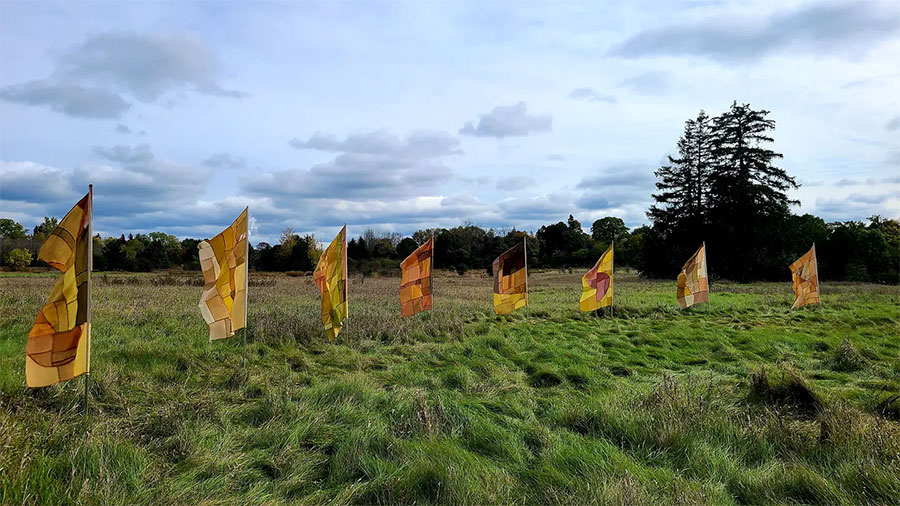
“Infinite Balance,” by Anita Cazzola, Yorklands Green Hub, Guelph ON, 2021. Photo by Jen Rafter.
Infinite Balance is a series of 8 naturally dyed patchwork flags, arranged in a quarter turn of a circle.
From left to right:
- Water Neighbours – Jewelweed, Joe-Pye Weed, Japanese Knotweed, Nettle
- Deciduous Trees – Trembling Aspen, Willow
- Buckthorn
- Curly Dock
- Black Walnut
- Flowers – Goldenrod, Wild Carrot, Sumac, Tansy, Ox-Eye Daisy
- St. John’s-wort
- Coniferous Trees – White Pine, Austrian Pine, Blue Spruce
Woven Timeline
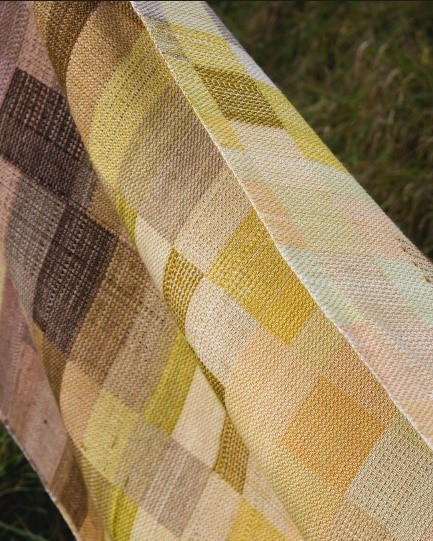
Photo by Anita Cazzola
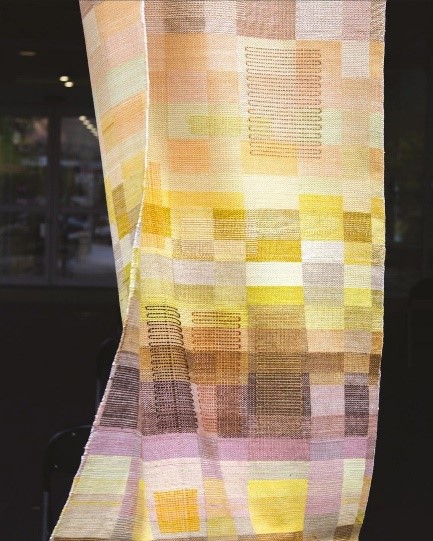
Photo by Jen Rafter
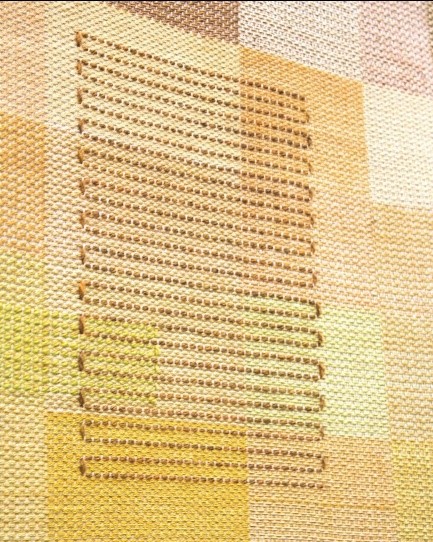
Photo by Anita Cazzola
A handwoven timeline of dye plants. The cloth’s warp was broken into sections based on the phases of the moon and month demarcations between the Summer Solstice and Autumn Equinox.
- Curly Dock (root, leaf, flower)
- St. John’s-Wort (root, leaf, flower)
- Ox-Eye daisy (flower)
- Plantain (leaf)
- Nettle (leaf)
- Mullein (leaf)
- Wild Carrot (flower)
- Dandelion (root, leaf, flower)
- Motherwort (leaf)
- Austrian Pine (cone)
- Black Walnut (shell)
- Tansy (flower)
-
- Curly Dock (dried flower)
- Buckthorn (bark, leaf, berry)
- White Pine (cone)
- Japanese Knotweed (leaf, dried and fresh)
- Jewelweed (whole plant)
- Joe-Pye Weed (flower)
- Blue Spruce (needle)
- Black Walnut (bark, leaf, hull)
- Trembling Aspen (bark, leaf)
- Sumac (berry)
- Goldenrod (flower)
- Willow (leaf)
Sun Flag

Solar-dyed with plants growing atop the Eastview Landfill. Jars of water, plant material, and fabric sat atop the Landfill for 1 month.
- Chicory
- Leafy Spurge
- Goldenrod
- Purple loosestrife
- St. John’s-wort
- Red Clover
- Vetch
- Wild Carrot
Partners and collaborators
- Jenna Kessler is a local illustrator, farmer, musician, and activist. Jenna will create botanical illustrations of local dye plants found during the residency. These will be used within the Dye Plants in Curious Spaces online archive, and as signage for the Self-guided plant walks.
- Zhyfhs Millicent of Planting Radiance is a local medicinal plant specialist who ran a series of socially distanced and live streamed plant walks in the summer of 2020. Zhyfphs will help lead the self-guided plant walks during this residency.
- Yorklands Green Hub has been advocating to transform the former Guelph Corrections Centre into a public domain space offering educational and research opportunities for our community.
About Anita Cazzola
Anita Cazzola is a textile and installation artist from Guelph. She completed her bachelor of fine arts at OCAD University in 2018, where she studied Sculpture and Installation and minored in Material Arts and Design with a focus in Textiles. Anita has exhibited her works within Ontario in solo and group exhibitions including Abbozzo Gallery, Toronto; 10C, Guelph; and Propeller Gallery, Toronto. She attended an artist residency at the Haystack Mountain School of Crafts (Deer Isle, Maine) in August 2019 and is also an accomplished musician (The Lifers, Annie Sumi, Samson Wrote).Follow Anita on Instagram @neatcazzola.
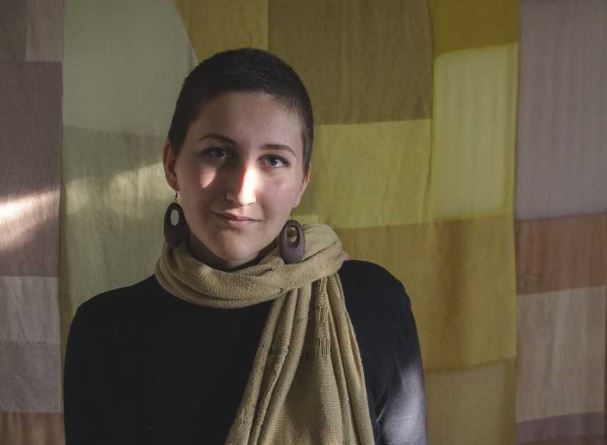
About the Artist in Residence program
The Artist in Residence program is offered by the City of Guelph to broaden the community’s experience of the arts. The annual program invites artists to engage with the public and showcase their creative practices while enlivening public spaces.
Program goals
- creatively animate public space(s) – indoor, outdoor and online
- provide opportunities for artists to engage virtually with the public to showcase their creative practices
- broaden the community’s experience of the arts
- contribute to placemaking and civic pride
The City of Guelph thanks all applicants who applied, including the 2021 Shortlisted Artists:
- Curtis Walker
- Michael James Castledine
For more information
Jen Rafter, Cultural Program and Event Coordinator
Culture and Recreation, Public Services
519-822-1260 extension 2629
[email protected]
